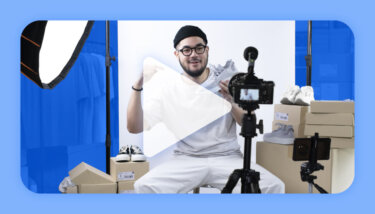Being a creator is exciting, but when you’re relying on brand deals and ad revenue, your income is likely to fluctuate. What if you could level up and turn your creativity into a business that brings in steady revenue that’s all built from your unique ideas?
We know it’s daunting to think of yourself as a business owner, which is why we’ve talked to creators just like you to share their own examples of scalable business ideas and how they’ve achieved success.
What makes a business scalable?
A scalable business is something that you can sustainably grow and develop over time, that will provide returns for the investment you put into it. To use a cheesy metaphor, think of it like a seed you plant in the ground and then nurture over time until you have a fully grown plant, and then you think: why not expand that into an entire vegetable patch to feed you and your family?
In other words, it’s something that you can start small and then expand into something bigger that’s going to sustain you in the long run.
A scalable creator business:
- Doesn’t trade time for money directly. Instead of getting paid per video or per post, you earn from assets you build once and sell repeatedly.
- Grows without relying on platform revenue. Ad revenue is at the mercy of algorithms, while scalable products let you own your audience relationships.
- Builds recurring income. Memberships, subscriptions, and communities generate predictable revenue from your audience paying you directly.
- Aligns with your brand and audience. The most sustainable ideas are natural extensions of the content you already create, addressing the needs of your audience.
An emerging trend in the creator economy is the shift from influencer to business owner, with creators taking on CEO roles. They want more than just to go viral online; they’re after long-term, sustainable growth that they can control.
Why multiple income streams are the key to success
Successful creators have a range of different revenue streams that make up their business. Just like freelancers enjoy the flexibility of earning income from multiple sources, creators can make the most of their creativity and take advantage of the various earning opportunities that come with that.
For example, Jade Beason offers a mixture of one-on-one consulting, a membership, and a one-off masterclass bundle as a digital product.
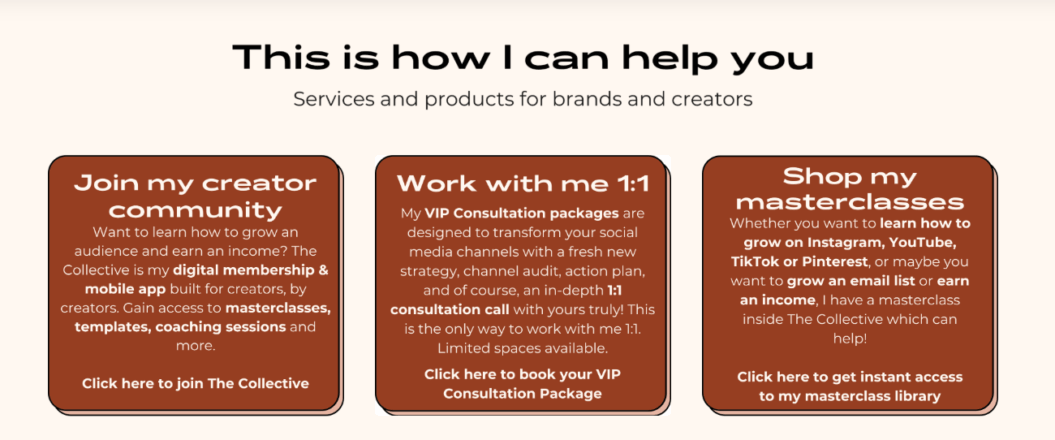
She talked to us about how she started to diversify her income to give her business the best chance to grow from multiple sources, beginning with an affiliate marketing strategy on YouTube and then growing an email list from there.
I scaled to $15k months in under one year by diversifying my income streams. I call these “money moves”.
These different income streams ensure that you have a consistent income coming in. If you make less from ad revenue one month, but you have a digital product that’s selling well, it gives you more control over your business and means that you’re not at the mercy of whatever the algorithm decides to do at any given moment.
It also protects you from the inevitable ups and downs of running your business. You might have peaks where your products and services sell well, but it takes time and effort for something like a membership to grow into a success, so that type of model isn’t going to be an overnight moneymaker. Some products may have more of a seasonal appeal, and you’ll need other income sources to fill in the gaps during the less popular times of the year.
Think of it like a portfolio:
- Recurring streams (like memberships and SaaS) provide stability.
- One-off sales (like digital products or merch) give cash injections.
- Licensing and partnerships open doors to long-term growth.
Let’s check out 11 scalable business ideas that you can use to build your creator business and bring in recurring revenue.
11 Scalable Business Ideas: from Memberships to Physical Products
1. Digital products
If you can stream, download, or use it, you can build it.
Digital products such as eBooks, templates, guides, and online courses are one of the easiest entry points into scalable income. They require upfront effort but can be sold unlimited times with no extra cost.
Why it works:
- Low overhead and minimal tech requirements.
- Great way to repurpose content (turn a YouTube series into a paid course, or bundle your templates into a “starter kit”).
- Can be validated quickly with a pre-sale or waitlist.
Once you’ve built and launched your product, the ongoing work comes from marketing it and enticing people to buy. You’ll need an ever-growing audience of potential buyers to keep making money from the same product, so nailing down the value and what they’ll gain from it is the key to making it work in the long run.
Creating digital products is a useful passive source of income. Once you’ve created it and found the best way to talk about it, you can set these up on autopilot without having to do much to generate sales.
Pro tip: Use your YouTube channel as a sales funnel for your digital products. Give your viewers a taster of your unique content and perspective, and keep the most valuable stuff in your paid content to entice them to buy.
Need inspiration? Check out our list of digital product ideas to get you started.
2. Start a membership
Membership communities let fans pay a recurring fee for access to exclusive content, private groups, or direct interactions with you. This model builds loyalty and provides a steady income.
Why it works:
- Recurring revenue equals predictable monthly income.
- Builds deeper relationships with your most engaged followers.
- Tiered pricing makes it accessible at different budget levels.
The video membership model relies on a steady stream of content and a great membership experience that your paying members want to keep coming back for. They’re not just passively consuming content, but actively engaging with it.
Kylie Julien advises how to get started with turning your video content into a scalable income:
To earn stable revenue from your video content, you need one of 2 things: a constant flow of new customers, or a set of customers who pay you consistently. The second of those two is a lot easier, which is why so many creators are building recurring businesses. Whether they call it a club, a mastermind group, a subscription, etc, they know that focusing on retention is a better route to sustainability.
Check out these killer membership website examples for ideas!
Creator spotlight:
The Curve Investing Club started out as group of 30 women meeting up to talk all things money. Then as their numbers grew and covid hit, founders Sophie and Victoria turned it into a podcast which hit 2 million downloads from dedicated listeners.
While it was resonating well with their audience, monetization was coming from podcast sponsorships so they decided to take the next step and scale into a membership model.
We asked ourselves, how can we give our audience a more intimate kind of offering? With a podcast, you can only go so far. A membership model meant people could dive deeper, and we could finally build something sustainable.
Since launching their app with Uscreen, The Curve Investing Club has grown its paid member base by 116.2%, seeing a revenue growth of 176.7%. Read the full story to learn how the right membership platform was key to building a scalable business that worked for them.
3. Start a streaming service
Video memberships or streaming libraries are one of the fastest-growing models for creators. Think of it as your own “mini Netflix” for niche content: fitness classes, tutorials, entertainment, or coaching videos.
Why it works:
- Gives fans on-demand access to your full video catalog.
- Lets you own your distribution instead of depending on YouTube ads.
- Easy to bundle live streams, recorded sessions, and exclusive drops.
Next Up Comedy, Means TV, and Home Rave are all great examples of Uscreen-built streaming services that create, produce, and sell their own content directly to subscribers for a recurring fee.
Means TV grew its monthly revenue to $40,000 after launching its Netflix-style streaming service with Uscreen. A big part of their success comes from offering TV apps to their subscribers, which makes up 65% of their viewership.
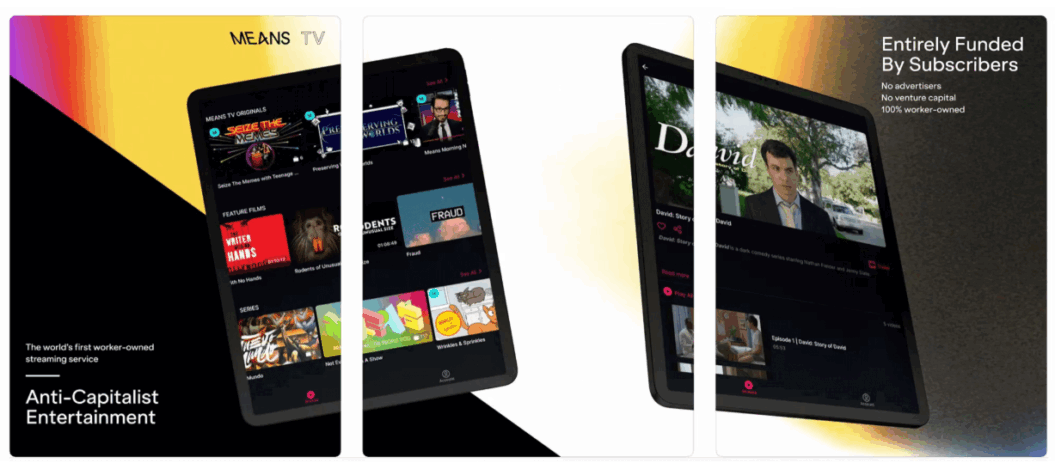
Starting your own streaming service isn’t as complicated as you might think; it’s just a case of using the right platform. We have it covered in 8 simple steps in our guide on how to start your own streaming service.
4. Launch a product line
Creators with strong brand identity can launch their own physical products like skincare, coffee, supplements, or tools that align with their niche.
Why it works:
- Extends your personal brand into the physical world.
- Higher perceived value compared to digital goods.
- Appeals to fans who want tangible ways to support you.
For example, take Chamberlain Coffee by Creator Emma Chamberlain, who runs the podcast ‘anything goes with emma chamberlain’ on YouTube.

She’s turned her energy and passion into a physical brand that both existing fans and general consumers can enjoy, with a range of products that people will naturally keep coming back to buy.
In the next couple of years, I think we’ll probably see more creator-led brands taking up space on our shelves with consumable products. There are so many potential categories, everything from cosmetics and skin care with the likes of Kylie Cosmetics down to gardening products by Epic Gardening, which began life as a blog and YouTube channel by founder and CEO Kevin Espiritu.
The challenge here is logistics and upfront investment; it requires more of a commitment than creating digital products, but if you have the reach, the potential for success is huge, and it’s a great way to get your name in front of more people.
5. Print-on-demand products + branded merch
For creators who want physical products without the inventory risk, print-on-demand is the answer. You design the product, and a partner handles printing, shipping, and fulfillment. Also known as dropshipping, when the customer buys the product, it’s printed and shipped by the manufacturer, so you don’t have to do anything.
Why it works:
- No upfront costs or storage needs.
- Perfect for testing designs and scaling based on what sells.
- Merchandise doubles as marketing when fans wear or use it.
It’s a low-risk way to extend your brand into physical goods and have an ongoing source of income that doesn’t require much maintenance.
For example, Redbubble is an online marketplace that uses this model for artists to sell their work. Creators like Fairydrop can offer multiple ways to sell their designs:
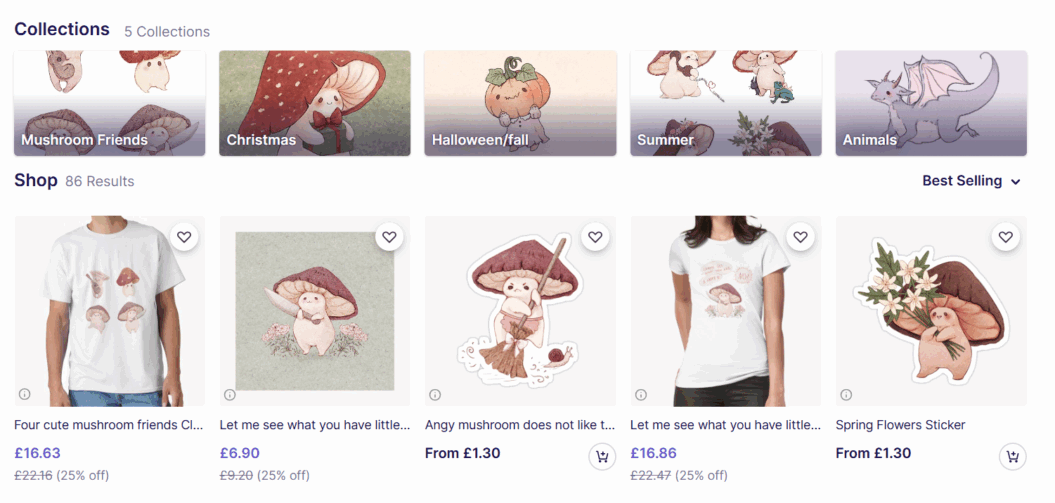
Lots of creators sell branded merch as an additional revenue stream, like Game Theory Shop. It’s a way of offering something tangible to your fans and giving them a way to support and connect with you in the offline world.
6. Create a niche marketplace/platform
If you’ve built authority in a specific area, you could create a platform that connects buyers and sellers in your niche — for example, a stock photo marketplace, a freelance talent platform, or a curated shop.
It’s a way of building a shared space for like-minded creators and professionals in your field, and establishing your expertise. For example, The Freelance Writing Network runs a daily pitch calls and job board hosted on Substack. It’s a relatively simple concept to set up using an existing platform, and they monetize by clearly outlining the value of being a paid subscriber:

Why it works:
- You earn commissions from every transaction.
- Positions you as the central hub in your niche.
- Can eventually scale into a community-driven business.
Building a marketplace or platform like this requires time and effort to get right. The success depends on meeting a need or demand within the market and creating something that is going to be worthwhile in the long run.
Etsy is an example of a bigger-scale marketplace that makes it easy for artists and creators to set up a store and sell their products on the site. It’s a great example of something scalable, because each seller is running their business autonomously and the site earns commissions through seller fees.
7. Create a custom AI service
AI tools are exploding, and creators are in a unique position to package their expertise into custom AI models or services. For example:
- A fitness influencer creating an AI workout planner.
- A chef launching an AI recipe generator.
- A music producer offering AI-assisted beat-making tools.
The possibilities are endless. Scriptwriter George Blackman created a custom GPT to help generate YouTube hooks, packaging it as an ‘AI scriptwriting toolbox.’ This takes his specific skill and scales it into a product that he can sell to help others do the same, without having to continuously create content or trade time for money as a coach.
Why it works:
- Differentiates you in a crowded space.
- High scalability once developed.
- Leverages trends audiences are already curious about.
Pro tip: Find a task or an area that creators like you find frustrating or time-consuming and put your own unique spin on it. Then turn this process into a series of specific steps that you can train AI to replicate consistently.
8. Social media consultant
If you’ve grown your own audience successfully, other creators, brands, or small businesses will pay for your expertise. Turning this into a productized service — like strategy templates, workshops, or subscription-based consulting — makes it scalable.
Jade Beason is a great example of this. She offers a package for her VIP consultancy services that interested creators can apply for, giving them the opportunity to learn from her directly based on her own success on social media.
Why it works:
- Leverages skills you already have.
- High demand as businesses struggle with digital presence.
- Can evolve into courses, memberships, or even your own agency.
Pro tip: Start small and find a way to package your expertise into a digital product or as a sellable service. Once you start to gain demand and clients, use this as the basis to scale and meet that demand by setting up a subscription-based membership, creating a one-off package that can sell continuously, or hiring a team to expand your business.
9. Build SaaS software
Creators with technical skills (or partnerships) can build software tailored to their niche. Think of niche tools like podcast analytics dashboards, art generators, or community management apps.
SaaS software is simply ‘Subscription as a Service’, so think of the software tools that you use and pay for on an ongoing basis. What type of tool do you wish you had but can’t seem to find anywhere? This could be your starting point for building the solution and turning it into a scalable business.
Take Novlr for example. It’s a novel writing software built by writers that provides an easy-to-use, cloud-based space for writing, and directly takes into consideration what users need and want from it.
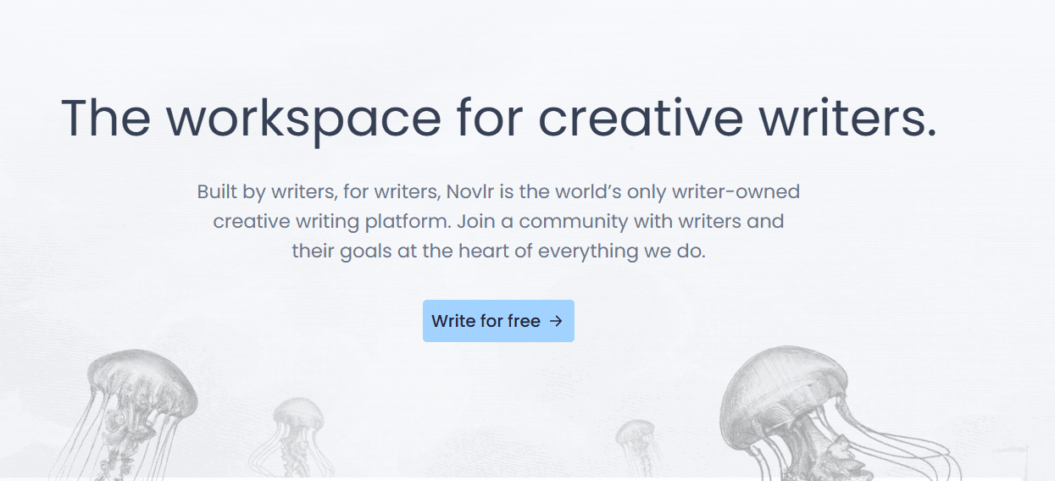
Why it works:
- Subscription model → recurring revenue.
- Extremely scalable once product-market fit is found.
- Deepens your brand authority in your space.
Building your own software is a long-term project that requires investment and a partnership with the right people who have the skills to bring your vision to life. However, the possibilities for scaling are endless, and it’s something you can develop and evolve over time.
10. Podcasting
Podcasts build authority, nurture communities, and open doors to multiple revenue streams (sponsorships, memberships, premium episodes, live shows). With repurposing tools, episodes can be turned into YouTube videos, clips, and even digital products.
It’s a popular and familiar format, and you can monetize through schemes like the Spotify Partner Programme. If you already have a large following or reach, then starting a podcast is a great option for making the most of that by giving your audience multiple ways to connect with and enjoy your content.
Ali Abdaal’s Deep Dive podcast for example, shares his productivity expertise with 561K subscribers, complementing the other areas of his productivity-led business, which includes his bestselling book and LifeOS productivity system.
Why it works:
- Great for creators who thrive in long-form conversation.
- Highly repurposable content.
- Easy to layer scalable monetization on top (memberships, courses, live events).
Check our guide to video podcasting and learn how to launch your own show in just 9 steps.
11. Licence intellectual property
Creators can scale by licensing their existing work — from artwork to video series to characters. This allows others to use your IP in exchange for royalties. There are several different ways you can do this, for example:
- Art & illustration for commercial products
- Music for background scores, commercials, etc
- Voice and image for advertising
- Ghostwriting
Platforms like Getty Images are popular places for photographers to license their work. This can be a scalable way to supplement your income to free up your time to work on other areas of your business.
Why it works:
- Income from work you’ve already created.
- Expands your reach into new audiences and industries.
- Low time investment once agreements are in place.
This is especially powerful for visual artists, educators, and entertainers with unique, recognizable content, and it’s scalable because once you’ve licensed the work, that will bring in ongoing royalties and tick away in the background.
What next?
Scalability for creators is about breaking free from the cycle of one-off deals and platform dependency. Whether you start small with digital products, build recurring income with memberships, or aim big with SaaS or licensing, the key is to choose the model that aligns with your audience and creative strengths.
You don’t have to launch everything at once — start with one idea, test it, and expand over time. With the right mix of recurring and one-off income streams, you can build a creator business that’s not only profitable but sustainable and fulfilling.
Obviously, we’re a big advocate for the membership model here at Uscreen. Why not check out our case studies for inspiration to see just how vast the possibilities are for starting a video membership and how these creators have scaled their businesses and achieved the lives they dreamed of.
Watch our quick platform demo to see how Uscreen can help you monetize your videos and grow your audience.







